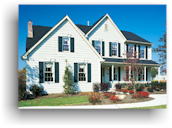
Financing Home Energy Efficiency Improvements
Energy-Efficient Mortgages
Benefits of EEMs
Financing Home Energy Efficiency Improvements Some energy efficiency improvements involve little or no implementation cost. There are also improvements that can cost a great deal of money. For example, replacing a heating system can cost up to $5,000 in a large house or even more if you are converting from electricity to another energy source. Installing new windows is another project that, while very beneficial to your home and the environment, can be a financial strain to implement. This is where energy efficiency financing comes in handy.
 |
Financing makes sense for many energy efficiency improvement projects. The
reason is that the improvements you make in your home will reduce your monthly utility
bills. In many cases, the amount of the reduction in utility bills will be greater than
the loan payment. So, your total monthly expenses go down while you enjoy the benefits of
a more energy-efficient home. Energy-Efficient Mortgages |
EEMs are offered by government and private institutions. The government agencies that secure this type of loan are the Federal Housing Authority (FHA) and the Department of Veterans Affairs (DVA). EEMs are also offered by private, secondary lending institutions such as the Federal National Mortgage Association (Fannie Mae) and the Federal Home Loan Mortgage Corporation (Freddie Mac). Some independent mortgage companies also offer EEMs.
Benefits of EEMs
There are three main benefits of EEMs over conventional loans. First, with an EEM you
will be able to exceed traditional loan limits. Second, you don't have to qualify for the
additional money. This means that you can add the cost of the improvements on to your
mortgage even if the total loan exceeds the amount for which you would normally qualify.
Since the energy efficiency improvements pay for themselves, they don't count against you.
Finally, under the EEM, 100% of the cost of the energy efficiency improvements can be
financed.
EEMs also come with special requirements. Most importantly, it is necessary to prove that the energy efficiency improvements are cost effective.
There are two criteria for cost effectiveness:
- The monthly utility savings must exceed the added monthly cost of the energy mortgage.
- The total savings must exceed the total cost (including maintenance) over the life of the improvement.
The improvements must meet both of these criteria to be considered cost effective and qualify for an EEM.
Most EEM lenders require an evaluation of the home's energy efficiency in order to qualify projects for a loan. The most widely accepted evaluation method is called the Home Energy Rating System (HERS). The HERS rating process is carried out by a certified rater or energy auditor. The HERS report identifies which improvements will be cost effective for the house and provides estimates of the monthly savings, the cost of the improvements, and the time it will take for the savings to pay back the cost.
The first step in obtaining an EEM is to contact potential lenders. The most comprehensive information on the EEM program can be found at the Residential Energy Services Network (RESNET). RESNET is a national network of mortgage companies, real estate brokerages, builders, appraisers, utilities, and other housing and energy professionals. For more information click on www.natresnet.org.
|
|
|
| Copyright Aclara Technologies LLC. All Rights Reserved. | |